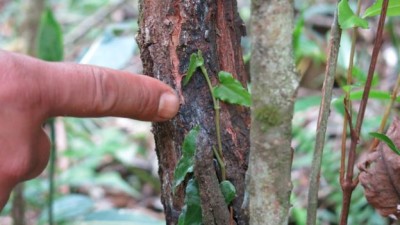
A relatively unheard of variety of pepper is growing in popularity among chefs. Could this citrusy variety replace black pepper on our dinner tables?
A wild pepper called tsiperifery has been winning over food connoisseurs around the world.
In France, Michelin-stared chef Anne-Sophie Pic likes to use the pepper with chocolate desserts.
In the US, celebrity chef Wolfgang Puck has written about it in his cookbooks and in the UK, you can now buy tsiperifery in the finest spice stores.
In Madagascar, where it comes from, I was served a fillet steak with tsiperifery sauce.
I found the tsiperifery stronger than normal pepper.
Its heat lingers in my mouth and there’s an acidic, citrus taste.
My dish was cooked by chef Hary Liva Rakotondravelo from La Varangue, one of the best-known restaurants in Madagascar’s capital Antananarivo.
Mr Rakotondravelo told me he has customers who come regularly to the restaurant just for the tsiperifery dish.
Until five years ago the pepper was almost completely unheard of internationally.
Consumption is still very, very limited.
Even in Madagascar, people don’t use the pepper extensively. Mr Rakotondravelo, however, thinks it has potential.
He is not the only one.
What is tsiperifery?
Pronounced tsee-pear-fair
Grows on vines up to 20m high
Found in Madagascar
Has a citrusy, hot taste
Olivier Ramaherison believes that one day tsiperifery could be on every table around the world, much like ordinary black pepper is today.
“You have to try it with cheese, with strawberries. With fish it’s amazing,” he enthuses.
He has big plans for the pepper.
He has started Madagascar’s first tsiperifery farm.
He is planting tens of thousands of seedlings in his forest.
“It’s going to be a kind of semi-domestication,” he said.
Tsiperifery grows on a vine so the plan is the seedling he has planted will use the trees as support.
And, if it works, Mr Ramaherison’s plan may help save the tsiperifery plant itself.
That’s because at the moment people who collect it in the wild sometimes cut down the whole vine to get the pepper.
The vines can grow up to 20m (66ft) high – it’s a long dangerous climb that many would rather avoid.
Instead, Mr Ramaherison will keep his vines in check at around 2.5m high, making the grains much easier to harvest without cutting the vine.
He also intends to employ people who would otherwise cut down wood for charcoal – which should protect the island’s forest.
That’s not the end of his plansAs he looked over the 440 hectares of his hilly forest, he told me that he hopes to control the whole tsiperifery market.
“We’re going to be like the Opec of tsiperifery,” he said, referring to the organisation that controls oil production.
But first he has to wait for his first yield.
He only started work three years ago and the first plants could take five years or more to produce fruit.
BBC
END

Be the first to comment